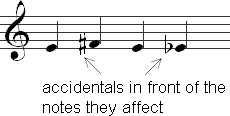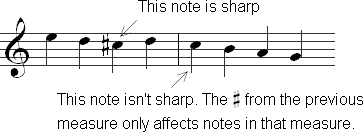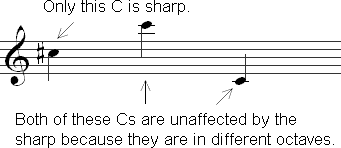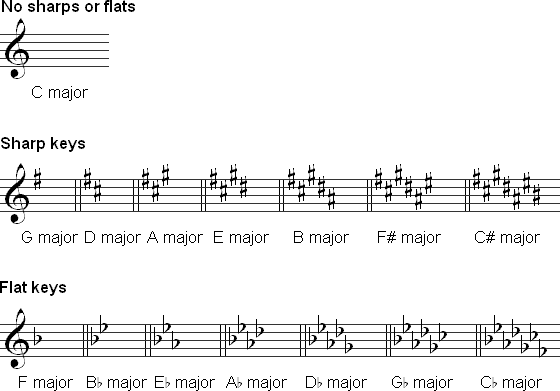Accidentals and Key Signatures
Accidentals
Accidentals raise or lower the pitch of a note by a half or whole step. There are five kinds of accidentals that are common: flats, sharps, double flats, and double sharps.
| Name | Image | Description |
|---|---|---|
| flats |  |
lowers a pitch of the note by a half step |
| sharps |  |
raises a pitch by one half step |
| double flats |  |
lowers a pitch by a whole step |
| double sharps |  |
lowers a pitch by a whole step |
| naturals |  |
cancels a previous accidental |
Placement of Accidentals
Accidentals are placed in front of the note that they affect.

Canceling Double Sharps and Flats
Double sharps and flats occasionally need to be canceled so that a single sharp, flat, or natural can be applied to a note in the same measure. This is generally done by placing a sharp, flat, or natural in front of the note. For example, the second note in the example below is a Bb. The flat doesn't lower the pitch a half step beyond the double flat. The double flat is canceled entirely by the new accidental.

Another approach is to use a natural and a single sharp or flat, but this is an older method that is rarely used today.

What to Call Notes with Accidentals
Notes with accidentals should be named using the note name plus the type of accidental. For example, a B with a flat in front of it is called B flat.
How Long an Accidental Lasts
An accidental only affects any notes in a measure after the accidental occurs.

Accidentals on Tied Notes
Notes that are tied from one measure to the next are affected by the accidentals in the previous measure. Any other notes in the measure other than the tied note aren't affected by the accidentals.

Which Notes are Affected by an Accidental
An accidental affects only the pitch in the octave that it precedes. Pitches in a different octave aren't affected. For example, the sharp in the following example only affects Cs on the third space of the staff. Neither of the other Cs are affected.

Cautionary Accidentals
Cautionary accidentals (or courtesy accidentals) are a reminder to play the correct pitch when a note that previously had an accidental is found in the next measure. They are often enclosed in parentheses. Cautionary accidentals aren't always used, so be sure to pay close attention to accidentals in all music you play.

Key Signatures
Key signatures are patterns of sharps or flats found at the beginning of a piece of music. They are used to simplify the use of accidentals in the music. Instead of having to write out each accidental individually, they are included in the key signature and apply to all pitches with that letter name. For example, a Bb in a key signature indicates that all Bs will be flat. Key signatures don't necessarily indicate the key, since a key signature with only F# could indicate G major, E minor, or a mode such as A dorian.
A chart of the key signatures for major keys is given below.

Sharps and flats in key signatures differ from accidentals that appear within the music in that they affect all pitches no matter which octave. For example, the F# in G major affects all Fs, not just the F on the fifth line of the staff.
Dealing with Accidentals When There is a Key Signature
It is important to remember accidentals in a key signature when dealing with accidentals found within the music itself.
- 1. A natural cancels a sharp or flat in a key signature for that measure only.
- 2. A flat or sharp in front of a note that is already flat or sharp in the key signature cancels a natural.
- 3. A double sharp or flat on a note that is flat or sharp in the key signature raises or lowers that pitch by one half step.
